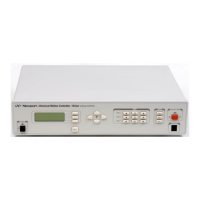1ac20 //set working acceleration to 20 deg/sec
2
1ag25 //set deceleration to 25 deg/sec
2
1fe0.5 //set following error threshold to 0.5 deg
1qd //update motor driver configuration
1qs100 //set micro-stepping resolution to 100x
1kp600 //set PID proportional gain to 600
1kd600 //set PID derivative gain to 600
1ki350 //set PID integral gain to 350
1ks300 //set PID integral saturation gain to 300
1tj1 //set trajectory mode to trapezoidal
sm //save configuration to non-volatile memory
Example #2: Stepper stage on axis 1
1qm3 //set motor type to commutated stepper
(ESP300 only)
1qi 1 //set motor maximum current to 1 amp
1qv30 //set motor voltage to 30 volts
1sn2 //set user units to millimeters
1su0.001 //set resolution to 1 micron
1fr0.01 //set stepper motor full step resolution to 10 micron
1vu20 //set maximum velocity to 20 mm/sec
1va10 //set working velocity to 10 mm/sec
1jh10 //set jog high velocity to 10 mm/sec
1jw1 //set jog low velocity to 1 mm/sec
1oh10 //set Homing velocity to 10 mm/sec
1au50 //set maximum acceleration to 50 mm/sec
2
1 ac 50 //set acceleration to 30 mm/sec
2
1ag30 //set deceleration to 30 mm/sec
2
1fe1 //set following error threshold to 1 mm
1tj1 //set trajectory mode to trapezoidal
1qd //update motor driver configuration
sm //save configuration to non-volatile memory
The following commands should be reviewed for proper axis
compatibility when connecting to a non-Newport stage – assuming
that it is electrically compatible with the controller (1.e., level 2):
ZA //set amplifier configuration
ZB //set feedback configuration
ZH //set hardware limit configuration
G-2 Appendix G – Programming Non-ESP Compatible Stages

